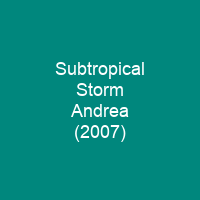Andrea was the first named storm to form in May in the Atlantic Ocean in 26 years. It was also the first pre-season storm to develop since Tropical Storm Ana in April 2003. Andrea caused large waves and tropical-storm force winds along the southeast coast of the United States. It is the first storm of the 2007 Atlantic hurricane season to be named.
About Subtropical Storm Andrea (2007) in brief

In some areas, the waves eroded up to 20 feet of beach, leaving 70 homes in danger of collapse, and three boats had to be rescued by the Coast Guard, although all nine sustained injuries. In early May, an upper-level trough dropped southward through the western Atlantic Ocean, forcing a back-door cold front—a cold front that moves southwestward ahead of a building surface ridge to its north or northeast—southward. For several days, forecast models had anticipated for the trough to evolve into a closed low pressure area, and on May 6, a frontal low with a large and well-defined circulation developed about 90 miles east of Cape Hatteras. On May 9, a Hurricane Hunters flight into the system revealed winds of 45 mph and a flat thermal core, which indicated the system was neither warm-core nor cold-core. The system changed little in organization throughout the day, though by the following morning, hurricane specialists indicated the low was acquiring subttropical characteristics as it tracked over progressively warmer waters.
You want to know more about Subtropical Storm Andrea (2007)?
This page is based on the article Subtropical Storm Andrea (2007) published in Wikipedia (as of Dec. 05, 2020) and was automatically summarized using artificial intelligence.







